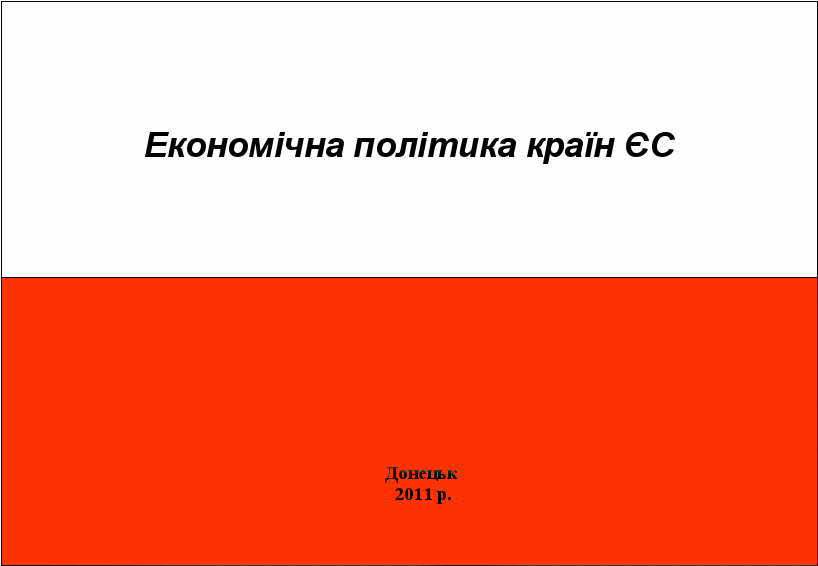Науково-практичної інтернет-конференції економічна політика країн єс 17 жовтня 2011 р., Донецьк м. Донецьк 2011 р. Ббк 65. 050. 11 Е 40
| Вид материала | Документы |
- Ренція «комплексне використанння природних ресурсів» (12 грудня 2011 року, м. Донецьк,, 2132.33kb.
- Де надруковано. Видавництво Вид роботи учб, 290.21kb.
- Всеукраїнська федерація «спас» запорізька облдержадміністрація запорізька обласна рада, 3474.89kb.
- Матеріали конференції будуть розміщені на web-ресурсі науково-практичних конференцій, 235.13kb.
- Програма ІІ міжнародної науково-практичної інтернет-конференції Аграрна наука ХХІ століття, 297.6kb.
- За загальною редакцією, 1428.32kb.
- Аспірантів та студентів які беруть участь у роботі Міжнародної науково-практичної інтернет-конференції, 4521.97kb.
- Управлінські аспекти підвищення національної конкурентоспроможності / Матеріали ІІІ, 4064.21kb.
- Матеріали ХVII міжнародної науково-практичної конференції удвох частинах Ч. I харків, 6941.25kb.
- Матеріали ХVII міжнародної науково-практичної конференції удвох частинах Ч. II харків, 5512.68kb.




MINISTRY OF EDUCATION, SCIENCE, YOUTH AND SPORTS OF UKRAINE
DONETSK NATIONAL UNIVERSITY OF THE ECONOMICS AND TRADE
NAMED AFTER MYKHAYLO TUGAN-BARANOVSKY
THE ACADEMY OF HOTEL MANAGEMENT AND CATERING INDUSTRY
INTERNATIONAL
SCIENTIFIC AND PRACTICAL
INTERNET-CONFERENCE
EUROPEAN UNION ECONOMIC POLICY
17 October, 2011 Donetsk
CONFERENCE PROCEEDINGS
Donetsk
2011
МІНІСТЕРСТВО ОСВІТИ І НАУКИ, МОЛОДІ ТА СПОРТУ УКРАЇНИ
ДОНЕЦЬКИЙ НАЦІОНАЛЬНИЙ УНІВЕРСИТЕТ ЕКОНОМІКИ І ТОРГІВЛІ
ІМЕНІ МИХАЙЛА ТУГАН-БАРАНОВСЬКОГО
АКАДЕМІЯ ГОТЕЛЬНОГО МЕНЕДЖМЕНТУ ТА ХАРЧУВАННЯ
МАТЕРІАЛИ
ІІІ МІЖНАРОДНОЇ
НАУКОВО-ПРАКТИЧНОЇ
ІНТЕРНЕТ-КОНФЕРЕНЦІЇ
ЕКОНОМІЧНА ПОЛІТИКА КРАЇН ЄС
17 жовтня 2011 р., Донецьк
м. Донецьк
2011 р.
ББК 65.050.11
Е 40
УДК 338.2
Е 40 Економічна політика країн ЄС : матер. міжнар. наук.-практ. конф., 17 жовт. 2011 р. м. Познань, Польша / М-во освіти і науки, молоді та спорту України, Донец. нац. ун-т економіки і торгівлі ім. М. Туган-Барановського, Акад.. готел. менедж. та харчування ; редкол. : Шубін О.О. (голов. ред..) [та ін.]. – Донецьк : [ДонНУЕТ], 2011. - 208 с.
Видається з 2009 р.
Редакційна колегія:
| Шубін О.О., д-р екон. наук (голов. ред); | dr Roman Dawid Tauber, prof. WSHiG |
| Садєков А.А., д-р екон. наук (заст. Голов. ред.); | dr Ewa Mucha-Szajek, prof. WSHiG |
| Азарян О.М., д-р екон. наук; | dr Elena Janina |
| Балабанова Л.В., д-р екон. наук; | prof., Dr.oec. Maija Šenfelde |
| Виноградова О.В., д-р екон. наук; | |
| Горожанкіна М.Є. д-р екон. наук; | |
| Фролова Л.В., д-р екон. наук; | |
| Чернега О.Б., д-р екон. наук; | |
| Самосьонок Л.М., канд. екон. наук; | |
| Абрашка О. В., ас. | |
Адреса редакційної колегії збірника:
83050, м. Донецьк, вул. Щорса, 31
ББК 65.050.11
© Донецький національний університет
економіки і торгівлі імені Михайла
Туган-Барановського, 2011
© Академія готельного менеджменту та
харчування, 2011
Alberto Viñas
Escola Universitària Salesiana de Sarrià
EU’s Smart Specialization Strategies Platform - Smart Growth in Europe 2020
In reality, regions are the primary institutional partners for universities, research and education institutes as well as SMEs and, therefore, they constitute the key to R&D and innovation making them an indispensible part of the Europe 2020 strategy.
The issue of specialization in R&D and innovation is particularly crucial for regions and countries which do not present a leading history in any of the major scientific or technological sectors. The smart specialization strategies are quite promising in this process as their objective is to encourage complementary combining regional productive assets associated with relevant sectors in the economy.
The knowledge and innovation capacity of regions depends on many factors such as business culture, education and training institutions, innovation support services, technology transfer mechanisms, R&D and ICT infrastructure, business incubators, new sources of finance or even local creative potential.
With 86 billion euro allocated to these policy areas, Member States and regions are committed to support this European strategy in order to maximize the impact of Regional Policy by ensuring a more effective use of public funds and by stimulating private investment.
Smart specialization is a concept for the development of the R&D and innovation policy of the European Union. Its aim is to promote efficient and effective use of public investment using the right synergies among countries and regions and strengthening their innovation capacity. This way, regional diversity can be developed even in less competitive areas by boosting their economic growth and prosperity. The process involves key factors coming from governmental, business, academic and other research institutions.
The smart specialization strategy consists of a multi-annual strategy program aiming to develop a functional national or regional research innovation system. Based on an analysis of the regional assets and technological studies, a developed strategy foresees potential partnerships with other regions and countries, and at the same time avoiding any overlapping or fragmentation of efforts. The whole strategy is based on the concept of a strong partnership between private and public entities with the collaboration of academic and research institutions.
The platform aims to assist the regions of the EU Member States to develop and implement new specialized synergies. The most important point in the process is the identification of high value added activities which offer better chances for competitiveness and integration in the market.
Among others, the smart specialization platform will provide analysis, expertise, advice, research, practical technical support, and the necessary training for the development of the new strategy, as well as a comprehensive toolbox based on the relevant EU policy.
The platform will also carry out a number of tasks intended to facilitate the exchange of experience from all regional and national initiatives and to identify the potential of cross-border cooperation through joint investment opportunities in specific innovative sectors.
A crucial element of smart specialization strategies is the presence of clusters, geographic concentrations of companies, often SMEs, which interact with each other and with clients and suppliers and often share a pool of specialist labor, business and financial services.
A key driver to R&D and innovation is public procurement since it is able to provide innovative firms with speed up measures to integrate the market. Innovation Partnerships is a new legal model to be established in the European market.
Research infrastructure in knowledge based innovation systems needs to be developed in order to help regions realize their full potential. This approach could be supported by the establishment of networks, the development of Regional Partner Facilities and the creation of the necessary ICT and research infrastructure for this scope.
The combination of these various aspects creates a new dynamic that goes beyond the specific sectors they represent. The pervasive impact of these synergies confirm the central role Smart Specialization strategy can play in the world economy, the EU economy and the EU’s economic recovery. Its effect will become apparent at the economic structure of the industrial compositions not only in advanced but also in emerging economies. The competitive asset of R&D and innovation will be fundamental as it is able to influence other sectors of the economy and develop key technologies on a global scale.
References:
- Attorney, Law Firm Directory. [Electron resource]. – Access mode:ссылка скрыта
- Information Technology and Innovation Foundation. [Electron resource]. – Access mode:http: //www.itif.org
Elena Janina, dr
The Academy of Hotel Management and Catering Industry
TRENDS IN INTERNATIONAL LABOUR MIGRATION
Nowadays process of international labour migration evolves constantly. It is stimulated consolidation of world concord, formation of global space, influence of global factors and pre-conditions. Conformities to law development of international labour migration obtain word character, determining the tendencies of intensification of migration flows and feature of migration relations of separate countries. In this time in comparing to the previous periods of history, importance of factors of military-political expansion and geographical openings reduced. Disintegration of the colonial and socialistic systems was given by a shove globalization of world labour market. Distribution of democracy as basic principle of the political and global system, and also forming of the global system of defence of rights and freedoms of human, resulted in bringing in the sphere of international labour migration of all world population. In establishment of conformities to law of development of international labour migration, it follows to take into account hierarchical differentiation of global factors among which primary and determining (that result in genesis of streams) demographic and economic. They are characterized as basic and permanent. Other factors (natural, social, civilization, informative, political and others) complement influence of main determinant and often touch separate parts of global space. Main pre-condition of increase of volumes of international labour migration is growth of quantity of population of Earth which is confirmed the results of global censuses.
According to experts of UN the quantity of population of the world will stably grow in future. Thus an unevenness will be saved between countries with the different level of economic development. Annual growth of population rates in developing countries on average in 6 times higher than in developed [1]. In obedience to the prognoses of UN part of population in age 60 and more in the world will be substantially increased: in 1950 – 8%, in 2009 – 11%, in 2050 – 22% [2]. The accelerations of processes of senescence of population in combination with reduction of birth-rate form new calls for the developed countries of the world.
From data of international organizations [4; 5] the world volume of labour resources in 2030 grows from 3 milliards persons to 4 milliards. The increase of labour resources after the different groups of countries goes unevenly. Growth of volume of labour resources in countries which develop in 2025 will exceed their general amount in the developed countries. In 2050 to labour resources in more developed countries are estimated in 600 billions persons, while in less developed they will be increased from 2,4 billions s in 2005 to 3 billions in 2020 and 3,6 billions in 2040. The demographic unbalanced is observed and in the change of structure of population, especially in relation to the increase of quantity of young people. In 2010 the general quantity of young people (15-24) in the world made 1218070 thousands persons, including more developed countries - 158571 thousand; the less developed regions - 1059499 thousands; the least the developed countries - 172779 thousands [4]. The median age in countries with very high (39.8 years in 2010) and high (30.4 years) level of human development significantly higher than in middle (28.6 years) and low (19.6 years ) level of development of human capability [4]. This global trend is the worsening situation of youth, which is typical for more and for less developed countries. While universal trends increase the general level of education in all countries there is low Youth Employment. According to [4], in middle and low human development there is a higher level of gender inequality, poverty, high intensity of deprivation (in education, health and living standards). For example, the national poverty line in 2000-2008 was in Slovakia amounted to 16.8%, Poland - 14.8%, Ukraine - 19.5%, Turkey - 27.0%, Romania - 28.9%, Mexico - 47.0% [4]. For countries with medium and low human development is characterized numerous human rights abuses, the growing number of victims of corruption, environmental degradation and access to services, increasing the population affected by natural disasters. For example, in the years 2000-2009 (average per year) to1 million people in Norway from natural disasters affected 49 people, USA - 7322, Sweden - 4, Finland - 8, Peru - 18032, Ukraine - 1561, Macedonia - 60,392, India - 55557, Kenya - 94526 etc. [4]. The high prevalence of malnutrition and deprivation relative intensity of food in some countries (Philippines, Indonesia, Syria, India and others.) Activity leads to internal migration, as well as in almost all countries to increase amount of refugees (for example, in 2008 Turkey - 214.4 thousand, Colombia - 373.5 thousand, China - 175.2 thousand, Vietnam - 328.2 thousand people, Afghanistan - 2,833.1 persons ) [4]. In countries with very high and high human development observed higher proportion of people satisfied with personal well-being (work, personal health, quality of life). In countries with medium and low human development level of this index significantly lower, and often observed negative feature of social environment (respectful attitude, social support network, etc.). Relevant trends observed in terms of crime and safety, satisfaction measures for the welfare of (affordable housing, quality health care, education system, air and water quality) [4].
Thus, there are objective demographic impulses facilitate international migration, expression of which depends on the panorama of economic development of countries and regions, structural changes in commercial complexes and international relations.
References
- Global Commission on International [Electron resource]. – Аccess mode:
